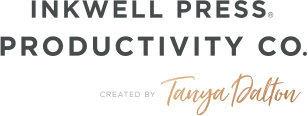We love to find articles that help us with planning, so when CNBC asked our founder Tanya Dalton, how she turned her 70-hour workweek into a 30-hour one, we were all ears! Tanya always has tips and tricks for making the most of our days, and these three will work for anyone, whether you have a planner or not.
Ever feel like your calendar is out of control? For years, Tanya worked nonstop every day, but she still felt like she hadn’t done enough when she got into bed at night. She knew something had to change, so she created three new strategies she still uses today.
Here are Tanya’s top three ways to boost productivity.
The Pomodoro technique – but in 60-90 minute increments
The Pomodoro technique is a classic way to get more done if your tasks are small. Just set a timer for 25 minutes and focus on only one set task. If you stick to it for all 25 minutes, you reward yourself with a five-minute break. Then you repeat the process four times until you reach a 20-minute break.
But what if you’re in a steady flow and a five-minute break would only distract you? Tanya says she prefers working for 60 to 90 minutes, then taking breaks at a good stopping point. This method allows for ample work time as well as sufficient recovery time.
As in all workday strategies, you should always find what works best for you and your job. Tanya says there’s no magic formula, and everyone should pay attention to their bodies to know when a break is needed. Writing down your tasks or setting a timer will ensure you don’t stay in break mode for too long.
Focus on tasks, not hours.
If you’re able, say no to the 40-hour workweek! Tanya says there’s no reason to factor time into your daily planning except to accommodate the schedules of others. She uses The Priority List method when she has a lot to do, which puts your most important tasks at the top of your list, regardless of how difficult they may be.
The Priority List should include just five to seven tasks. With this method, you may get fewer tasks done at the end of the day, but your prioritized tasks will be complete, and you may get some extra time for yourself.
Check out Tanya’s Oxford Talk to learn more about prioritizing tasks over time, and see our Classic Weeklyand Priority List inserts to help you write your priorities and get them done.
Check-in with yourself as needed.
Here’s a vital appointment to keep. Tanya makes an appointment with herself once every quarter for personal reflection. She considers the pace of her schedule, her family life, and her work life, and what she likes and dislikes about her life. If changes are needed, this is when she decides to make them. During one of these sessions, she saw how chaotic and imbalanced her life had become, so you could say that the inspiration for her Oxford Talk came to her during a check-in!
Are you ready to embrace a new way of working? Consistency is key, but by prioritizing rest, focusing on tasks, and checking in with yourself, you can take control of your life and feel more satisfied at the end of each day.
Adapted for our blog from the CNBC story, “This former CEO cut her 70-hour workweek down to 30 with 3 productivity hacks—start with ‘tossing your to-do list” published online on July 11, 2023.

